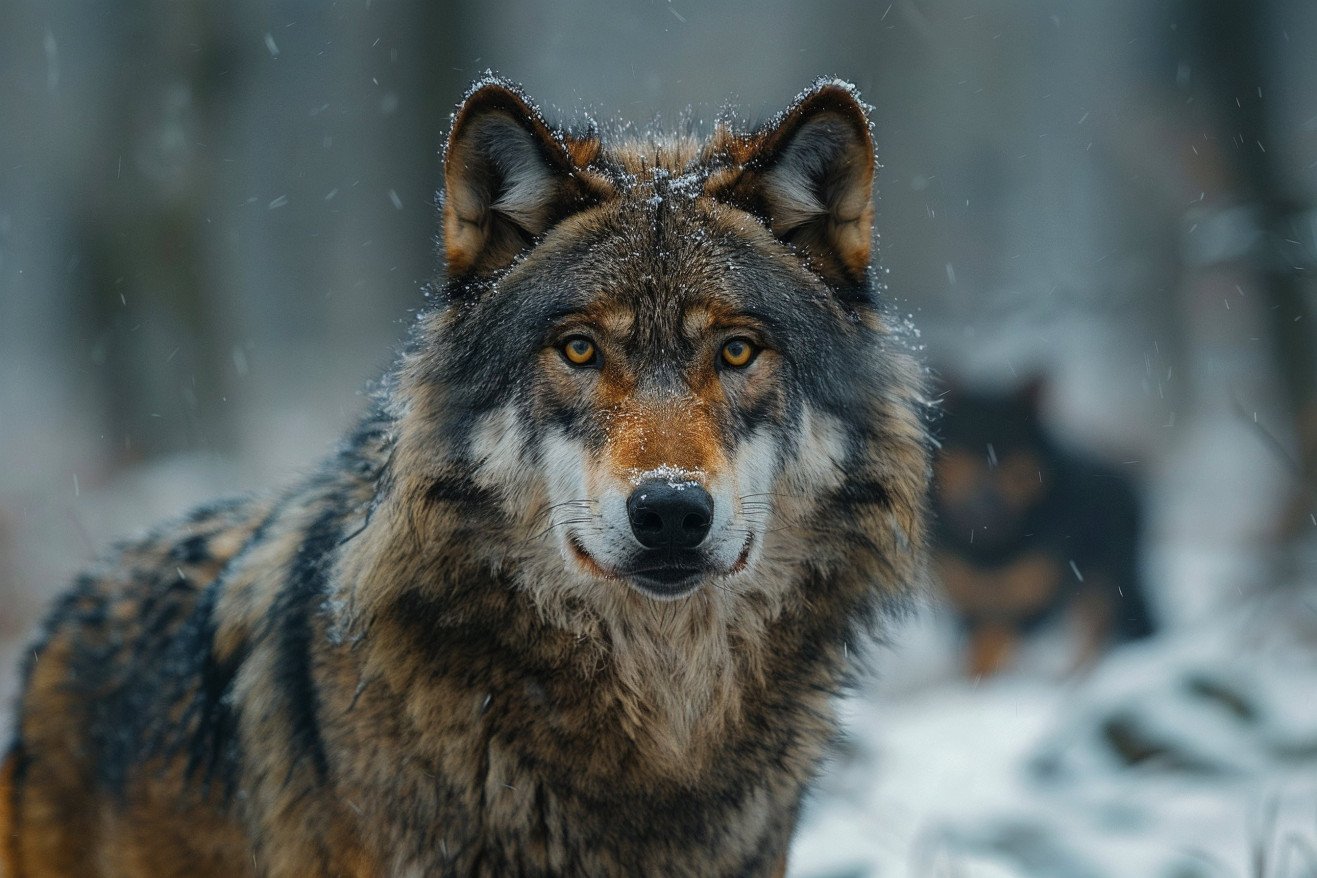Wolves vs Dogs: Why the Huge Difference in Size?
1 April 2024 • Updated 1 April 2024

The difference in size between wolves and dogs can provide valuable information about the evolutionary history of these two closely related canids. Although dogs are one of the most diverse species in terms of size, with some dogs weighing as little as a few pounds and others weighing as much as 200 pounds, the gray wolf is consistently much larger, with males weighing more than 175 pounds and standing over 6 feet tall on their hind legs.
This article will review studies from a number of scientific disciplines, including genetics, paleontology, and zoology, to explain the many factors that have led to the large size difference between wolves and dogs. It will show how selective breeding, differences in diet, and the need to adapt to different environments have shaped the physical attributes of these animals over thousands of years. It will also discuss how size has impacted hunting strategies, social structures, and survival in the wild for both wolves and dogs.
How big is a wolf compared to a dog?
Anatomical Differences: Skulls, Jaws, and Teeth
The most obvious anatomical differences between wolves and dogs can be found in their skulls, jaws, and teeth. Wolves have larger and stronger skulls, jaws, and teeth than dogs, which is thought to be an adaptation to their role as an apex predator that needs to bite through the bones and tough skin of their prey in the wild. The larger skull size of wolves allows for more powerful jaw muscles and enables the larger teeth that are more suitable for capturing, killing, and eating large prey.
Wolves also have a higher number of robust molars and premolars that are sharper and better suited for crushing bones and tearing through the tough skin of their prey. Their wider snout and larger jaw also give them a much stronger bite force than domestic dogs, which is necessary for hunting and consuming large prey with hooves, such as deer, elk, and moose.
These differences in the skull, jaw, and teeth of wolves and dogs show how wolves have evolved as cooperative pack hunters and apex predators in the wild, while dogs have been bred for generations to serve a wide variety of purposes that don't require the same hunting adaptations.
Pack Dynamics and Social Behaviors
Wolves live in packs, which are complex family units that work together to hunt, defend their territory, and raise their young. A study published by the journal PMC notes that wolves have a clear division of labor within their packs, with dominant breeding members leading the pack and subordinates helping to care for the offspring through a process called "alloparenting" - the cooperative care of pups by non-parental pack members.
In addition to this division of labor, wolves also exhibit post-conflict behaviors like reconciliation and consolation that help to keep the peace within the pack, behaviors that have been shown to be less common in domestic dogs due to their less social nature. A study conducted at the Cornell University College of Veterinary Medicine found that wolves were more likely to exhibit prosocial, cooperative behaviors toward their pack members than dogs that were raised in similar conditions.
Although wolf packs were once believed to be organized by a strict dominance hierarchy, more recent studies have shown that wolf packs are more complex, with multiple breeding pairs and a variety of roles for subordinate members. In contrast, dogs are more dependent on humans and lack the complex social structures and cooperative behaviors of wolf packs.
Hunting Strategies and Prey Selection
Wolves are highly social and efficient hunters that primarily hunt large prey, such as moose, deer, and elk, in packs. One study found that while the most typical way for a wolf to hunt is with its pack, a lone wolf can still successfully take down a moose. Wolves usually attack their prey from behind to avoid the animal's forehooves and kill by biting the neck or snout. This study also found that the bite marks left by wolf packs on their prey are unique and can be distinguished from dog bites by the size and shape of their jaws and teeth.
In contrast, a study found that domestic dogs, while they are capable of preying on wild species, primarily depend on human-derived resources, leading most scientists to describe them as scavengers with a specialization in exploiting human waste. As a result, wolves' hunting strategies and prey selection are shaped by their evolutionary history as an apex predator, while dogs have evolved to live a more domesticated life that prioritizes human social bonds and interactions.
Differences in Size Between Wolf Species and Subspecies
While wolves are generally larger than domestic dogs, there is a lot of variation in size between the different wolf species and subspecies. In the United States, there are two species of wolf: the gray wolf (Canis lupus) and the red wolf (Canis rufus). The International Wolf Center notes that the red wolf is smaller than the gray wolf and is only found in a small area of coastal North Carolina.
On the other hand, the gray wolf has several subspecies, some of which are much larger than others. Data from the Seacrest Wolf Preserve indicates that the largest gray wolf subspecies is the Northwestern Wolf (Canis lupus occidentalis), which can reach up to 7 feet in length and weigh up to 72 kg (160 lbs). In general, as noted by Animal Corner, wolves in colder, higher latitude climates are larger than those in warmer, lower latitude climates, which is likely due to natural selection.
In addition to the Northwestern Wolf, other notable gray wolf subspecies include the Eurasian Wolf, the Arctic Wolf, and the Mongolian Wolf, all of which have different size characteristics. According to Live Science, the Eastern Wolf (Canis lupus lycaon) is also a separate species that is found in parts of the United States and Canada. Knowing the differences in size between these wolf species and subspecies is important for conservation efforts and managing human-wolf interactions.
Size Differences and Conservation Implications
The larger size of wolves has important implications for their survival as apex predators. A study published in the journal PMC notes that the size and cohesiveness of wolf packs are important for both feeding pups and protecting kills from other animals. Larger packs are better able to do both of these things, showing how the physical size of wolves helps them succeed as predators.
At the same time, the physical characteristics that make wolves such effective predators can also lead to conflicts with humans, especially in areas where livestock or game animals are present. In fact, the study points out that several wolf subspecies, including the Steppe Wolf and the Himalayan Wolf, are either endangered or have very limited ranges because of human activities like habitat destruction, hunting, and other threats.
Therefore, it is important to understand the size differences and ecological roles of wolves in order to develop conservation plans that can help protect these animals and reduce human-wolf conflicts. As noted by GrayWolfConservation.com, saving endangered wolf subspecies will require a holistic approach that takes into account the unique adaptations and behaviors that have resulted from their physical characteristics.
By understanding the evolutionary pressures that have led to the extreme size differences between wolves and domestic dogs, we can help ensure the survival of these amazing apex predators.
Conclusion: The Evolutionary Divergence
The extreme differences in size between wolves and domestic dogs are a clear example of the evolutionary divergence of these two closely related species. Wolves have maintained their large size, strong jaws, and cooperative hunting strategies as they have evolved to be the top predator in their natural environment. Meanwhile, domestic dogs have been shaped by human selective breeding and domestication, leading to a wide variety of sizes and shapes that have been bred for specific tasks.
While some dog breeds may be as big as or bigger than some subspecies of wolves, wolves are generally larger and have better endurance, strength, and hunting abilities than dogs. By studying the differences in size and the traits that go along with it, we can learn more about the evolutionary history and ecological niches of these two species.


